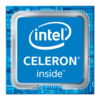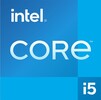Intel Celeron 5305U vs Intel Core i5-12450H vs Intel Core i5-12500H
Intel Celeron 5305U
► remove from comparison
The Intel Celeron 5305U is a low-power dual-core SoC for laptops, based on the Comet Lake architecture, which was introduced in 2020. Compared to Kaby Lake and Whiskey Lake, there are apparently no differences with Comet Lake apart from the two additional cores in the Top model Core i7-10710U. The processor is still manufactured using the mature 14nm process (14nm++ like Whiskey Lake). The processor cores clock at a fixed 2.3 GHz (no Turbo) and also only offer 2 threads (no HyperThreading). Compared to the more powerful Core i3, i5 and i7 variants, the Celeron does not offer SSE (2) support.
You can find more information about the Comet Lake architecture and the available processors on our Comet Lake topic page.
According to Intel, the integrated graphics card is called Intel UHD Graphics, but is an old Intel UHD Graphics 610. It is clocked in the Celeron 5205U at 300 - 900 MHz and is only sufficient for very demanding games. The CPU also offers an integrated DDR4-2666 / LPDDR4x 2933 / LPDDR3-2133 dual-channel memory controller as well as VP9 and H.265 video decoder and encoder.
Performance
The performance of the Celeron 5305U is in the lowest entry-level class of notebook processors in 2020. Due to the lack of Turbo and only 2 cores, the CPU cannot score points in either single-core or multi-core tasks. The processor is therefore only suitable for undemanding tasks such as surfing with a few tabs and office tasks.
The power consumption and performance can be set from 15 to 12.5 watts by the notebook manufacturer via cTDP-down. However, the processor then only runs at 800 MHz and significantly reduced performance. Even at 15 watts, however, the processor is suitable for thin and light notebooks.
Intel Core i5-12450H
► remove from comparison
The Intel Core i5-12450H is a high-end mobile CPU for laptops based on the Alder Lake architecture. It was announced in early 2022 and offers 4 of the 6 performance cores (P-cores, Golden Cove architecture) and 4 of the 8 efficient cores (E-cores, Gracemont architecture) leading to 8 cores in total (octa core CPU). The P-cores support Hyper-Threading leading to 12 supported threads when combined with the E-cores. The clock rate ranges from 2 to 4.4 GHz on the performance cluster and 1.5 to 3.3 GHz on the efficient cluster. The performance of the E-cores should be similar to old Skylake cores (compare to the Core i7-6700HQ). All cores can use up to 12 MB L3 cache. Compared to the 12500H, the 12450H offers less E-cores, lower clock rates, a slower iGPU and no vPro support.
Performance
The average 12450H in our extensive database is a bit of a disappointment, its multi-thread benchmark scores only just matching those of the Ryzen 7 5700U and the Core i7-10750H, both fairly old chips as of Q2 2023.
Your mileage may vary depending on how high the CPU power limits are and how competent the cooling solution of your system is.
Features
The integrated memory controller supports various memory types up to DDR5-4800, DDR4-3200, LPDDR5-5200, and LPDDR4x-4267. The Thread Director (in hardware) can support the operating system to decide which thread to use on the performance or efficient cores for the best performance. For AI tasks, the CPU also integrates GNA 3.0 and DL Boost (via AVX2). Quick Sync in version 8 is the same as in the Rocket Lake CPUs and supports MPEG-2, AVC, VC-1 decode, JPEG, VP8 decode, VP9, HEVC, and AV1 decode in hardware. The CPU only supports PCIe 4.0 (x8 for a GPU and two x4 for SSDs).
The integrated graphics adapter is based on the Xe-architecture and offers 48 of the 96 EUs (Execution Units) operating at up to 1.2 GHz.
The CPU is rated at 45 W base power (95 W PL2) but most laptops will use a PL1 of around 60 Watt. The SoC is manufactured in a 10nm process at Intel, which is known as Intel 7.
Intel Core i5-12500H
► remove from comparison
The Intel Core i5-12500H is a high-end mobile CPU for laptops based on the Alder Lake architecture. It was announced in early 2022 and offers 4 of the 6 performance cores (P-cores, Golden Cove architecture) and all 8 efficient cores (E-cores, Gracemont architecture). The P-cores support Hyper-Threading leading to 16 supported threads when combined with the E-cores. The clock rate ranges from 2.5 to 4.5 GHz on the performance cluster and 1.8 to 3.3 GHz on the efficient cluster. The performance of the E-cores should be similar to old Skylake cores (compared to the Core i7-6700HQ). All cores can use up to 18 MB L3 cache. Compared to the 12600H, the 12500H offers base clock for both clusters, a slower clocked iGPU and only "Essentials" vPro support.
Performance
The average 12500H in our database is in the same league as the Ryzen 9 6900HS, Ryzen 9 6900HX, Core i7-12650H and also the Core i9-11900H, as far as multi-thread benchmark scores are concerned. For something that's supposedly a mid-range chip, this kind of performance is just outrageously good, as of Q3 2023.
Thanks to its decent cooling solution and a long-term CPU power limit of 80 W, the Gigabyte G7 KE is among the fastest laptops built around the 12500H that we know of. It can be more than 40% faster in CPU-bound workloads than the slowest system featuring the same chip in our database, as of August 2023.
Architecture
The integrated memory controller supports various memory types up to DDR5-4800, DDR4-3200, LPDDR5-5200, and LPDDR4x-4267. The Thread Director (in hardware) can support the operating system to decide which thread to use on the performance or efficient cores for the best performance. For AI tasks, the CPU also integrates GNA 3.0 and DL Boost (via AVX2). Quick Sync in version 8 is the same as in the Rocket Lake CPUs and supports MPEG-2, AVC, VC-1 decode, JPEG, VP8 decode, VP9, HEVC, and AV1 decode in hardware. The CPU only supports PCIe 4.0 (x8 for a GPU and two x4 for SSDs).
The integrated graphics card is based on the Xe-architecture and offers 80 of the 96 EUs (Execution Units) operating at up to 1.3 GHz.
Power consumption
This Core i5 has a "minimum assured" power consumption of 35 W. Its Base power consumption sits at 45 W and its maximum Intel-recommended Turbo power consumption isn't supposed to exceed 95 W. A high-performance cooling solution is a must for a CPU like this one here.
Last but not he least, Intel Core i5-12500H is manufactured on Intel's fourth-generation 10 nm process marketed as Intel 7 for decent, as of late 2022, energy efficiency.
| Model | Intel Celeron 5305U | Intel Core i5-12450H | Intel Core i5-12500H | ||||||||||||||||||||||||||||||||||||||||||||||||||||||||||||||||||||||||||||||||||||||||||||||||
| Codename | Comet Lake-U | Alder Lake-H | Alder Lake-H | ||||||||||||||||||||||||||||||||||||||||||||||||||||||||||||||||||||||||||||||||||||||||||||||||
| Series | Intel Comet Lake | Intel Alder Lake-P | Intel Alder Lake-P | ||||||||||||||||||||||||||||||||||||||||||||||||||||||||||||||||||||||||||||||||||||||||||||||||
| Series: Alder Lake-P Alder Lake-H |
|
|
| ||||||||||||||||||||||||||||||||||||||||||||||||||||||||||||||||||||||||||||||||||||||||||||||||
| Clock | 2300 MHz | 1500 - 4400 MHz | 1800 - 4500 MHz | ||||||||||||||||||||||||||||||||||||||||||||||||||||||||||||||||||||||||||||||||||||||||||||||||
| Cores / Threads | 2 / 2 | 8 / 12 | 12 / 16 | ||||||||||||||||||||||||||||||||||||||||||||||||||||||||||||||||||||||||||||||||||||||||||||||||
| TDP | 15 Watt | 45 Watt | 45 Watt | ||||||||||||||||||||||||||||||||||||||||||||||||||||||||||||||||||||||||||||||||||||||||||||||||
| Technology | 14 nm | 10 nm | 10 nm | ||||||||||||||||||||||||||||||||||||||||||||||||||||||||||||||||||||||||||||||||||||||||||||||||
| max. Temp. | 100 °C | 100 °C | 100 °C | ||||||||||||||||||||||||||||||||||||||||||||||||||||||||||||||||||||||||||||||||||||||||||||||||
| Socket | BGA1528 | BGA1744 | BGA1744 | ||||||||||||||||||||||||||||||||||||||||||||||||||||||||||||||||||||||||||||||||||||||||||||||||
| Features | LPDDR3-2133/DDR4-2400 RAM, PCIe 2, 4 GT/s bus, MMX, SSE, SSE2, SSE3, SSSE3, SSE4.1, SSE4.2, AVX, AVX2, BMI2, ABM, FMA, ADX, VMX, SMEP, SMAP, MPX, EIST, TM1, TM2, SST, AES-NI, RDRAND, RDSEED, SGX | DDR4-3200/LPDDR4x-4266/DDR5-4800/LPDDR5-5200 RAM, PCIe 4, Thr. Director, DL Boost, GNA, MMX, SSE, SSE2, SSE3, SSSE3, SSE4.1, SSE4.2, AVX, AVX2, BMI2, ABM, FMA, ADX, VMX, SMX, SMEP, SMAP, EIST, TM1, TM2, HT, Turbo, SST, AES-NI, RDRAND, RDSEED, SHA | DDR4-3200/LPDDR4x-4266/DDR5-4800/LPDDR5-5200 RAM, PCIe 4, Thr. Dir., DL Boost, GNA, vPro Ess., MMX, SSE, SSE2, SSE3, SSSE3, SSE4.1, SSE4.2, AVX, AVX2, BMI2, ABM, FMA, ADX, VMX, SMX, SMEP, SMAP, EIST, TM1, TM2, HT, Turbo, SST, AES-NI, RDRAND, RDSEED, SHA | ||||||||||||||||||||||||||||||||||||||||||||||||||||||||||||||||||||||||||||||||||||||||||||||||
| iGPU | Intel UHD Graphics 610 (300 - 900 MHz) | Intel UHD Graphics Xe G4 48EUs ( - 1200 MHz) | Intel Iris Xe Graphics G7 80EUs ( - 1300 MHz) | ||||||||||||||||||||||||||||||||||||||||||||||||||||||||||||||||||||||||||||||||||||||||||||||||
| Architecture | x86 | x86 | x86 | ||||||||||||||||||||||||||||||||||||||||||||||||||||||||||||||||||||||||||||||||||||||||||||||||
| $107 U.S. | |||||||||||||||||||||||||||||||||||||||||||||||||||||||||||||||||||||||||||||||||||||||||||||||||||
| Announced | |||||||||||||||||||||||||||||||||||||||||||||||||||||||||||||||||||||||||||||||||||||||||||||||||||
| Manufacturer | ark.intel.com | ark.intel.com | ark.intel.com | ||||||||||||||||||||||||||||||||||||||||||||||||||||||||||||||||||||||||||||||||||||||||||||||||
| L1 Cache | 704 KB | 1.1 MB | |||||||||||||||||||||||||||||||||||||||||||||||||||||||||||||||||||||||||||||||||||||||||||||||||
| L2 Cache | 8 MB | 10 MB | |||||||||||||||||||||||||||||||||||||||||||||||||||||||||||||||||||||||||||||||||||||||||||||||||
| L3 Cache | 12 MB | 18 MB |
Benchmarks
Average Benchmarks Intel Celeron 5305U → 100% n=2
Average Benchmarks Intel Core i5-12450H → 695% n=2
Average Benchmarks Intel Core i5-12500H → 802% n=2
* Smaller numbers mean a higher performance
1 This benchmark is not used for the average calculation













